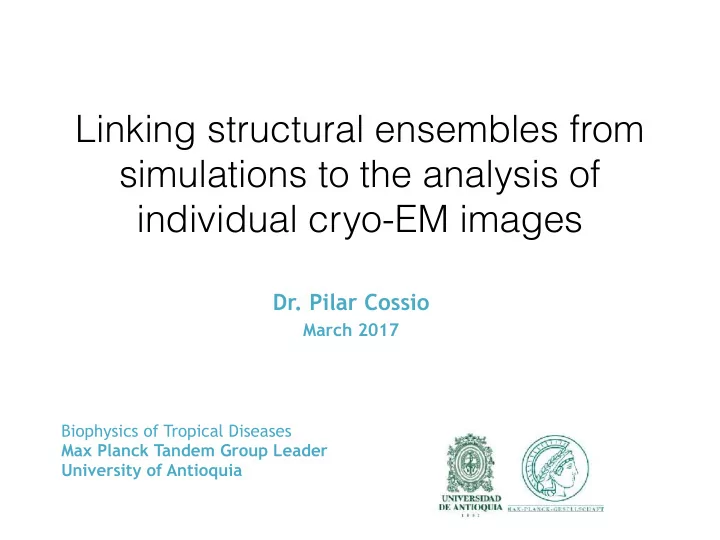

Linking structural ensembles from simulations to the analysis of individual cryo-EM images Dr. Pilar Cossio March 2017 Biophysics of Tropical Diseases Max Planck Tandem Group Leader University of Antioquia
Outline • Motivation: Hybrid methods • Introduction to cryo-Electron Microscopy • Cryo-EM of dynamic systems? – BioEM: Bayesian inference of individual cryo- EM images – Integrating simulations and BioEM for the analysis of dynamic systems • Conclusions
Motivation: Hybrid/ Integrative Methods
MD Simulations Protein folding Molecular Dynamics have obtained both the structures and dynamics of proteins: Drug Design Ubiquitin folding. Piana et al. PNAS Allosteric (2013) 110 , 5915–5920. Modulation of a G-protein- site coupled receptor by allosteric Orthosteric drugs site Dror et al. (2013) Nature . 503: 295-299 Limited computation-time, force field accuracy?
MD simulations can now be used to make predictions. However, not all systems /phenomena can yet be studied with MD. e.g., Large systems with more than 10 7 atoms or times scales greater than ms .
Structural Experiments 3D structure/map X-ray crystallography Cryo-electron NMR (nuclear microscopy magnetic resonance) High Resolution (atomic) structures However, ensemble average: limits the interpretation and extraction of dynamic information.
Single-molecule Experiments Dynamics Rates Free energy k o Unfolding Forces Δ G # x # FRET (fluorescence Force spectroscopy resonance energy transfer) Limited structural information.
Hybrid methods: Integrate information from both experiments and simulations.
Integrate the methods to understand biomolecules Structural Experiments Single- Simulations molecule 9
Requires novel methods: And many more…
cryo-EM
Cryo-EM: Frozen Biological sample EM Imaging imaged with an electron microscope A 1 A o ATP- synthase from Pyrococcus furiosus from Matteo 25 nm Allegretti. Challenge: Images are noisy!
3D reconstructions EM Imaging Requirements: • Relatively large systems. • Symmetric systems with common features for clustering. • Non-dynamic systems. • Hundreds of thousands of particles are needed to Image from compbio.berkeley.edu obtain a good resolution.
3D reconstructions EM Imaging Assumptions: • All particle-images are in a single conformational state • The particle-image orientations are randomly distributed • Sometimes the molecular Image from compbio.berkeley.edu symmetry.
3D reconstructions near atomic EM Imaging resolution : Bacteriophage T4, Nature Commun, 7548 (2015) actomyosin complex, Nature, 534, 724 -728 (2016) Large ribosomal subunit, Science , And many more… 348 , 95-98 (2014). Cryo-EM has revolutionized structural biology!
What to do when the EM reconstruction methods fail? BioEM: Bayesian inference of individual EM images
of dynamic/flexible EM Imaging and asymmetric biomolecules? Dr. Gerhard Hummer Models Bayesian inference of electron microscopy (BioEM): obtain the Images probability of each model given a set of EM images. Cossio , Hummer. (2013) J. Struct. Biol. 184: 427-37.
EM Imaging Parameters Likelihood function: Obs | I Cal ) = exp( − 2 / 2 λ Obs − I 2 L ( I ∑ ( I Cal ( θ )) ) pix Noise
Bayesian Analysis: Integrate the likelihood over all possible parameters and include prior information too. For an individual image Priors Parameters For multiple images
EM Imaging Model Ranking/ Comparison
GroEL Chaperonin: a test system GroEL+ATP APO EM (same data) X-ray EM (same data) X-ray X-ray cryo-EM images in the APO state X-ray EM (same data) Cumulative Evidence EM (same data) X-ray Worse X-ray
Linking to structural ensembles from simulations
Information from cryo-EM images of structural ensembles (e.g. flexible biomolecules)? ESCRT-I complex Boura et al. PNAS, 108 , 9437–9442 (2011)
Posterior BioEM probability of sets of models where the model weights are normalized
-) Maximum entropy: optimize the weights ( ) of each model to fit best the data. -) Minimum ensemble: minimum number of structures that best represent the data.
Minimum ensemble method validated with the ESCRT I-II supercomplex* We generated 4 sets each with 200 synthetic images using random parameters and equal weights Set1 Set2 Set4 Radius of gyration Set3 *Boura et al. Structure. 20 : 874–886 (2012).
Minimum Ensemble? • The posterior increases sharply until the number of models reaches the actual ensemble size, as indicated by arrows. • The minimum number of members of the ensemble is that by which adding an extra member does not increase the posterior Number of models m
However, the calculation of BioEM posteriors for large numbers of particles and models is computationally demanding. Building a fast code
BioEM + GPUs* ~20000 ~100000 https://gitlab.rzg.mpg.de/ MPIBP-Hummer/BioEM * Cossio , et al. (2017) Compu. Phys. Commun. 210, 163-171.
BioEM perfomance over CPUs and GPUs * Cossio , et al. (2017) Compu. Phys. Commun. 210, 163-171.
BioEM Applications
Imaging What is the most probable c-ring stoichiometry Archaea ATP-synthase? Application 51000 particles 13 Å resolution c10 Unpublished data 5 nm 5 nm A 1 A o ATP-synthase from Pyrococcus furiosus Collaboration with Prof. Dr. Kühlbrandt, Dr. Vonck, Dr. Allegreti. Max Planck Biophysics
C-ring Models Imaging Application Monomer from c10 crystal c(8) - ring Soluble part + c-ring (7,8, 9,10 sym.) 45° + detergent c(9) - ring from 3D reconstruction 40°
BioEM Probability Imaging Discrimination: Application Cumulative log Probability with 1 st = c9 Better Reference respect to c10 2 nd = c10 3 rd = c8 ~3500 particles collected from a 4 th = c7 Falcon Microscope
Current & Future work 3D Reconstruction Refinement: Improve the • resolution of a 3D map using BioEM BioEM Ensemble refinement with coarse-grained simulations • using the BioEM minimal ensemble method BioEM gradient-based simulations/refinement: use the • BioEM posterior as a biasing force
Max Planck Tandem Group Biophysics of Tropical Diseases Welcome to Colombia: Guests are Welcome!
Acknowledgements Dr. Gerhard Hummer Prof. Dr. Alessandro Laio Thank you for your attention
Recommend
More recommend